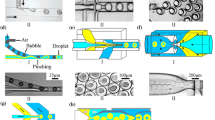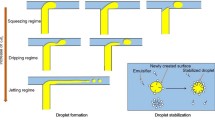Abstract
Microfluidic devices can form monodisperse double emulsions, but the fabrication steps are complicated and require specialized equipment. Recently, a method to convert single emulsions into double emulsions using vortex mixers has been proposed. Using this method, we demonstrate the production of double emulsions using commercially available single-emulsion microfluidic chips. We characterize the effect of vortex speed, vortex duration and the number of vortex/flick cycles on the average diameter and coefficient of variation of the double emulsions. Using fluorescent nanoparticles as tracers, we show that droplet breakup occurs during the second emulsification (using the vortex), but did not observe any fusion between the cores of double emulsion droplets. We also found that some inverted double emulsion droplets containing the outer water phase in their core were produced during vortex emulsification. Finally, while commercial chips only exist with a finite range of channel size that sets the monodispersed emulsion droplet radius, we show that the double-emulsion droplet radius can be adjusted using osmotic pumping. Our method is simple, available and user-friendly for biomedical researchers.








Similar content being viewed by others
References
Abate AR, Krummel AT, Lee D, Marquez M, Holtze C, Weitz DA (2008) Photoreactive coating for high-contrast spatial patterning of microfluidic device wettability. Lab Chip 8(12):2157–2160
Abate AR, Thiele J, Weinhart M, Weitz DA (2010) Patterning microfluidic device wettability using flow confinement. Lab Chip 10(14):1774–1776
Al-Bataineh SA, Szili EJ, Gruner PJ, Priest C, Griesser HJ, Voelcker NH et al (2012) Fabrication and operation of a microcavity plasma array device for microscale surface modification. Plasma Processes Polym 9(7):638–646
Bernath K, Hai M, Mastrobattista E, Griffiths AD, Magdassi S, Tawfik DS (2004) In vitro compartmentalization by double emulsions: sorting and gene enrichment by fluorescence activated cell sorting. Anal Biochem 325(1):151–157
Chong D, Liu X, Ma H, Huang G, Han YL, Cui X et al (2015) Advances in fabricating double-emulsion droplets and their biomedical applications. Microfluid Nanofluid 19(5):1071–1090
Chou W-L, Lee P-Y, Yang C-L, Huang W-Y, Lin Y-S (2015) Recent advances in applications of droplet microfluidics. Micromachines 6(9):1249–1271
Hai M, Bernath K, Tawfik D, Magdassi S (2004) Flow cytometry: a new method to investigate the properties of water-in-oil-in-water emulsions. Langmuir 20(6):2081–2085
Kim SC, Sukovich DJ, Abate AR (2015) Patterning microfluidic device wettability with spatially-controlled plasma oxidation. Lab Chip 15(15):3163–3169
Lagus TP, Edd JF (2013) A review of the theory, methods and recent applications of high-throughput single-cell droplet microfluidics. J Phys D Appl Phys 46(11):114005
Liao Q-Q, Zhao S-K, Cai B, He R-X, Rao L, Wu Y et al (2018) Biocompatible fabrication of cell-laden calcium alginate microbeads using microfluidic double flow-focusing device. Sens Actuators, A 279:313–320
Mastrobattista E, Taly V, Chanudet E, Treacy P, Kelly BT, Griffiths AD (2005) High-throughput screening of enzyme libraries: in vitro evolution of a β-galactosidase by fluorescence-activated sorting of double emulsions. Chem Biol 12(12):1291–1300
Mutafopulos K, Spink P, Lofstrom C, Lu P, Lu H, Sharpe J et al (2019) Traveling surface acoustic wave (TSAW) microfluidic fluorescence activated cell sorter (μFACS). Lab Chip 19(14):2435–2443
Nawar S, Stolaroff JK, Ye C, Wu H, Xin F, Weitz DA (2020) Parallelizable microfluidic dropmakers with multilayer geometry for the generation of double emulsions. Lab Chip 20(1):147–154
Okushima S, Nisisako T, Torii T, Higuchi T (2004) Controlled production of monodisperse double emulsions by two-step droplet breakup in microfluidic devices. Langmuir 20(23):9905–9908
Romanowsky MB, Heymann M, Abate AR, Krummel AT, Fraden S, Weitz DA (2010) Functional patterning of PDMS microfluidic devices using integrated chemo-masks. Lab Chip 10(12):1521–1524
Romero PA, Abate AR (2012) Flow focusing geometry generates droplets through a plug and squeeze mechanism. Lab Chip 12(24):5130–5132
Rotem A, Abate AR, Utada AS, Van Steijn V, Weitz DA (2012) Drop formation in non-planar microfluidic devices. Lab Chip 12(21):4263–4268
Shahi P, Kim SC, Haliburton JR, Gartner ZJ, Abate AR (2017) Abseq: ultrahigh-throughput single cell protein profiling with droplet microfluidic barcoding. Sci Rep 7(1):1–12
Shang L, Cheng Y, Zhao Y (2017) Emerging droplet microfluidics. Chem Rev 117(12):7964–8040
Shui L, Van Den Berg A, Eijkel JC (2009) Interfacial tension controlled W/O and O/W 2-phase flows in microchannel. Lab Chip 9(6):795–801
Sohrabi S, Moraveji MK (2020) Droplet microfluidics: fundamentals and its advanced applications. RSC Adv 10(46):27560–27574
Suea-Ngam A, Howes PD, Srisa-Art M, DeMello AJ (2019) Droplet microfluidics: from proof-of-concept to real-world utility? Chem Commun 55(67):9895–9903
Sukovich DJ, Kim SC, Ahmed N, Abate AR (2017) Bulk double emulsification for flow cytometric analysis of microfluidic droplets. Analyst 142(24):4618–4622
Vladisavljević GT, Khalid N, Neves MA, Kuroiwa T, Nakajima M, Uemura K et al (2013) Industrial lab-on-a-chip: design, applications and scale-up for drug discovery and delivery. Adv Drug Deliv Rev 65(11–12):1626–1663
Wang X, Zhu J, Shao T, Luo X, Zhang L (2019) Production of highly monodisperse millimeter-sized double-emulsion droplets in a coaxial capillary device. Chem Eng Technol 42(6):1330–1340
Wang J, Hahn S, Amstad E, Vogel N (2022) Tailored double emulsions made simple. Adv Mater 34(5):2107338
Acknowledgements
This work was supported by the National Natural Science Foundation of China with Grant Nos. 12004078, 51950410582, and 61874033, the Science and Technology Commission of Shanghai Municipality Nos 22QA1400900 and 22WZ2502200, and the State Key Lab of ASIC and System, Fudan University with Grant No. 2021KF003, 2020KF006, 2021MS001 and 2021MS002. This work was supported by the Fundamental Research Funds for the Central Universities with Grant No. D5000210626. This project was also supported by Institut Pasteur (PTR 393-ZOOFOAMENV) as well as the Chinese Academy of Sciences, a Shanghai Municipal Science and Technology Major Project (Grant No. 2019SHZDZX02).
Author information
Authors and Affiliations
Corresponding authors
Ethics declarations
Conflict of interest
The authors have no relevant financial or non-financial interests to disclose.
Additional information
Publisher's Note
Springer Nature remains neutral with regard to jurisdictional claims in published maps and institutional affiliations.
Supplementary Information
Below is the link to the electronic supplementary material.
Rights and permissions
Springer Nature or its licensor holds exclusive rights to this article under a publishing agreement with the author(s) or other rightsholder(s); author self-archiving of the accepted manuscript version of this article is solely governed by the terms of such publishing agreement and applicable law.
About this article
Cite this article
Lin, S., Mao, L., Ying, J. et al. Generation of double emulsions from commercial single-emulsion microfluidic chips: a quality-control study. Microfluid Nanofluid 26, 71 (2022). https://doi.org/10.1007/s10404-022-02575-7
Received:
Accepted:
Published:
DOI: https://doi.org/10.1007/s10404-022-02575-7




